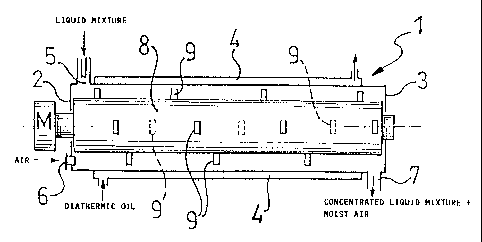Some of the information on this Web page has been provided by external sources. The Government of Canada is not responsible for the accuracy, reliability or currency of the information supplied by external sources. Users wishing to rely upon this information should consult directly with the source of the information. Content provided by external sources is not subject to official languages, privacy and accessibility requirements.
Any discrepancies in the text and image of the Claims and Abstract are due to differing posting times. Text of the Claims and Abstract are posted:
| (12) Patent: | (11) CA 2217906 |
|---|---|
| (54) English Title: | METHOD FOR THE CONCENTRATION OF LIQUID MIXTURES |
| (54) French Title: | METHODE DE CONCENTRATION DE MELANGES LIQUIDES |
| Status: | Term Expired - Post Grant Beyond Limit |
| (51) International Patent Classification (IPC): |
|
|---|---|
| (72) Inventors : |
|
| (73) Owners : |
|
| (71) Applicants : |
|
| (74) Agent: | OYEN WIGGS GREEN & MUTALA LLP |
| (74) Associate agent: | |
| (45) Issued: | 2006-12-05 |
| (22) Filed Date: | 1997-10-09 |
| (41) Open to Public Inspection: | 1998-04-10 |
| Examination requested: | 2002-08-09 |
| Availability of licence: | N/A |
| Dedicated to the Public: | N/A |
| (25) Language of filing: | English |
| Patent Cooperation Treaty (PCT): | No |
|---|
| (30) Application Priority Data: | ||||||
|---|---|---|---|---|---|---|
|
The present invention relates to a method for the concentration of liquid mixtures, comprising the step of causing a continuous stream of the liquid mixtures to flow in the form of a turbulent thin layer in contact with a heated wall. For that purpose, a continuous stream of liquid mixture is fed into a turbo-concentrator comprising a cylindrical tubular body (1), a heating jacket (4) and a bladed rotor (8) rotatably supported in the cylindrical tubular body (1). The liquid mixture is centrifuged to form a dynamic and tubular thin layer, the thin layer advancing inside the cylindrical tubular body (1) then being discharged continuously in the form of a stream of concentrated liquid mixture.
La présente invention concerne une méthode de concentration des mélanges liquides, comprenant l'étape de provocation d'un débit continu des mélanges de liquides s'écoulant sous forme d'une couche fine turbulente en contact avec une paroi chauffée. A cet effet, un débit continu de mélange de liquides est alimenté dans un turbo-concentrateur comprenant un corps tubulaire cylindrique (1), une jaquette chauffante (4) et un rotor à lames (8) soutenu de manière rotative dans le corps tubulaire cylindrique. Le mélange liquide est centrifugé pour former une couche dynamique et tubulaire fine, la couche fine s'avançant à l'intérieur du corps tubulaire cylindrique (1) puis étant déchargée continuellement sous forme d'un débit de mélange de liquide concentré.
Note: Claims are shown in the official language in which they were submitted.
Note: Descriptions are shown in the official language in which they were submitted.

2024-08-01:As part of the Next Generation Patents (NGP) transition, the Canadian Patents Database (CPD) now contains a more detailed Event History, which replicates the Event Log of our new back-office solution.
Please note that "Inactive:" events refers to events no longer in use in our new back-office solution.
For a clearer understanding of the status of the application/patent presented on this page, the site Disclaimer , as well as the definitions for Patent , Event History , Maintenance Fee and Payment History should be consulted.
| Description | Date |
|---|---|
| Inactive: Expired (new Act pat) | 2017-10-09 |
| Letter Sent | 2007-02-27 |
| Inactive: Payment - Insufficient fee | 2007-02-27 |
| Inactive: Entity size changed | 2007-02-06 |
| Inactive: Office letter | 2007-02-06 |
| Inactive: Corrective payment - s.78.6 Act | 2006-12-22 |
| Final Fee Paid and Application Reinstated | 2006-12-22 |
| Reinstatement Request Received | 2006-12-22 |
| Grant by Issuance | 2006-12-05 |
| Inactive: Cover page published | 2006-12-04 |
| Deemed Abandoned - Failure to Respond to Maintenance Fee Notice | 2006-10-10 |
| Inactive: Final fee received | 2006-08-02 |
| Pre-grant | 2006-08-02 |
| Inactive: IPC from MCD | 2006-03-12 |
| Notice of Allowance is Issued | 2006-02-10 |
| Letter Sent | 2006-02-10 |
| Notice of Allowance is Issued | 2006-02-10 |
| Inactive: Approved for allowance (AFA) | 2005-11-01 |
| Amendment Received - Voluntary Amendment | 2005-10-05 |
| Inactive: S.30(2) Rules - Examiner requisition | 2005-06-20 |
| Letter Sent | 2002-09-26 |
| Request for Examination Received | 2002-08-09 |
| Amendment Received - Voluntary Amendment | 2002-08-09 |
| Request for Examination Requirements Determined Compliant | 2002-08-09 |
| All Requirements for Examination Determined Compliant | 2002-08-09 |
| Application Published (Open to Public Inspection) | 1998-04-10 |
| Classification Modified | 1998-01-29 |
| Inactive: IPC assigned | 1998-01-29 |
| Inactive: First IPC assigned | 1998-01-29 |
| Inactive: IPC assigned | 1998-01-29 |
| Inactive: Courtesy letter - Evidence | 1997-12-23 |
| Filing Requirements Determined Compliant | 1997-12-18 |
| Inactive: Filing certificate - No RFE (English) | 1997-12-18 |
| Application Received - Regular National | 1997-12-17 |
| Inactive: Single transfer | 1997-12-12 |
| Abandonment Date | Reason | Reinstatement Date |
|---|---|---|
| 2006-12-22 | ||
| 2006-10-10 |
The last payment was received on 2006-09-22
Note : If the full payment has not been received on or before the date indicated, a further fee may be required which may be one of the following
Please refer to the CIPO Patent Fees web page to see all current fee amounts.
Note: Records showing the ownership history in alphabetical order.
| Current Owners on Record |
|---|
| VOMM CHEMIPHARMA S.R.L. |
| VOMM CHEMIPHARMA S.R.L. |
| Past Owners on Record |
|---|
| CORRADO VEZZANI |